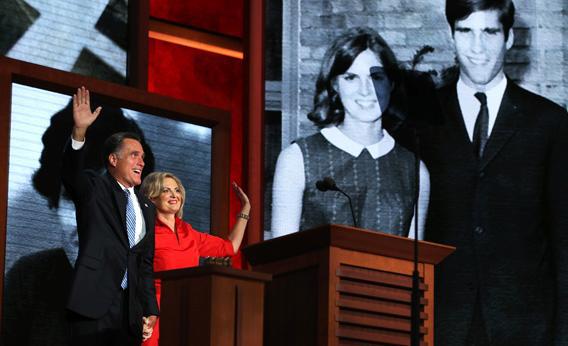During her Tuesday night speech at the Republic National Convention, Ann Romney talked about meeting her future husband at a high-school dance. It worked out for Ann and Mitt Romney, but do statistics support the decision to marry your high-school sweetheart?
Probably not. Marrying young is one of the most reliable predictors of divorce, especially for women. Those who wed during their teens—Ann Romney was about a month shy of 20 when she married Mitt in 1969—have only a 54 percent chance of remaining married for 10 years. Marrying between the ages of 20 and 24 boosts those odds to 69 percent, while holding off until age 25 lifts the 10-year marriage survival rate to 78 percent. It should be noted that Ann Romney’s marital behavior was fairly typical of her generation: In 1970, the average first-time bride was approximately 21 years old. Today, the average is 26 years old. By some calculations, that change accounts for most of the decline in the national divorce rate over the past 30 years.
You shouldn’t necessarily bid your love interest a tearful and permanent farewell on graduation day, however. It’s not exactly unbiased, peer-reviewed research, but a study published last year by the online dating service eHarmony suggests that those who find their spouses at school have relatively happy unions. Using the Couples Satisfaction Index, which asks subjects to rate their relationships on such issues as overall happiness, time spent together, and cooperation, the researchers determined that couples who met in school (including higher education) were happier than those who met through friends or family, or at a bar. Classmate couples scored slightly lower than those who met at church. Those who met in school were also less likely to divorce than people who met in any other setting (aside from eHarmony, of course, at least according to its own data).
Conventional wisdom might hold that the Romneys’ Mormon faith diminished their likelihood of divorce, but religion actually plays a somewhat complicated role in the success of a marriage. The divorce rate for Mormons is slightly higher than that of the general population during the first three years of marriage, probably because Mormon women marry younger than their non-LDS peers. Mormons who make it through that adjustment period, however, are more likely than other Americans to remain married. In addition, Ann Romney was an Episcopalian when she met Mitt, but, by some accounts, she was raised in a largely nonreligious household. That would render her more likely to divorce than people raised by more religious families.
One statistical factor working in the Romney marriage’s favor was the couple’s geographic location. According to recent studies, couples in left-leaning, blue states are significantly less likely to divorce. The divorce rate in the Romneys’ current home state, Massachusetts, is the lowest in the country, and Michigan, where they wed, boasts fewer divorces per capita than bright-red Utah.
Got a question about today’s news? Ask the Explainer.
Explainer thanks Dana Rotz of Mathematica Policy Research and Jay Teachman of Western Washington University.
